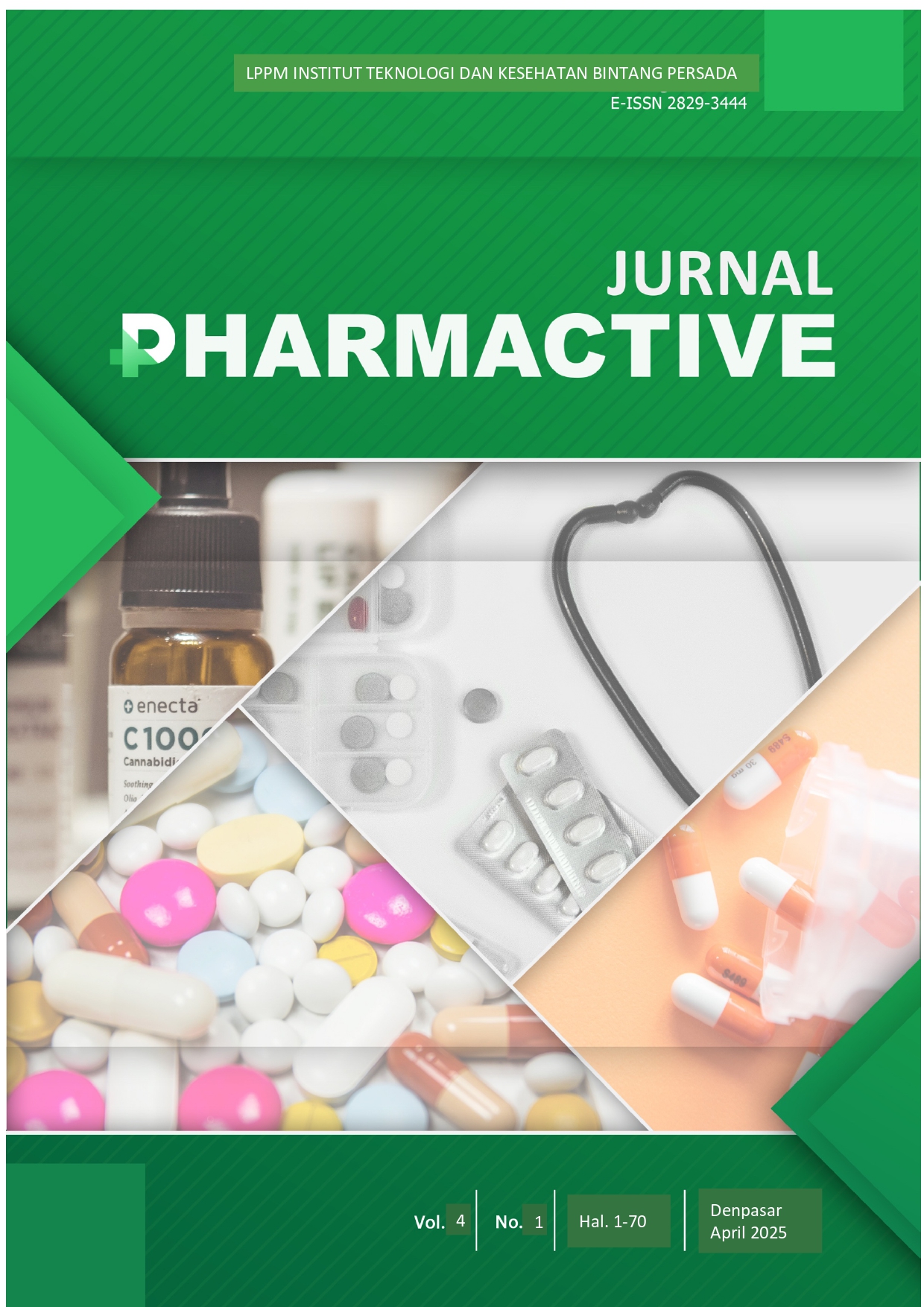KAJIAN PERESEPAN RACIKAN STUDI RETROSPEKTIF PADA PASIEN PEDIATRI RSUD KABUPATEN TEGAL
Keywords:
Drug interactions, pediatric, prescription concoctionsAbstract
The treatment of pediatric patients requires special attention because the organ systems of children are immature and continue to develop as they grow, concoction prescriptions are often found in pediatric patients, The demand for concoction prescriptions in pediatric patients arises from various specific needs of the patients such as administering a dose based on body weight, difficulty swallowing. Drug mixtures in concoction prescriptions increase the risk of drug incompatibility and interactions,Tthe research conducted was a cros sectional research with a retrospective approach. The data was 127 prescriptions concocted by outpatients in 2024, analyzed using Medscape stokley’s drug interactions, and literature study. The results showed that of 127 patients with male patients, 71 patients (55.9%) were female while the number of female patients was (44.1%). In the one-year period 52 cases (40.94) were found with dosage inaccuracies and stability problems in two cases (5.51%). From the analysis of 127 prescriptions, it was found that 66 prescriptions (52%) involved drug interactions with a moderate level of severity. The most common interactions occurred in combinations such as Catroptil + Furosemide + Lactosum, Tremenza + Salbutamol + Lactosum, and Phenytoin + Lactosum. Additionally, the potential for pharmaceutical problems was found to be an average of (46.46)
Keywords: Drug interactions, pediatric, prescription concoctions.
References
[1]S. S. Shah and N. R. Gaikwad, “Drug metabolism in pediatric patients:Pharmacokinetic considerations.,”Pediatric Pharmacology and Therapeutics, vol. 26, no. 2, pp. 145– 154, 2021, doi: https://doi.org/10.5863/1551-6776- 26.2.154.
[2] I. M. Y. D. A. Putra, I. N. C. Setiawan, and K. P. Budiana, “Hubungan usia, jenis kelamin, dan pemberian asi eksklusif dengan kejadian pneumonia pada balita di puskesmas gunung sari,” vol. 9, no. 1, pp. 73–82, 2025.
[3] https://doi.org/10.1007/s40272-021- 00497-x. Rashed, A. N., Wong, I. C., Cranswick, N., Tomlin, S., & Rascher, W. (2022). Risk factors associated with adverse drug reactions in children: A systematic review. Pediatric Drugs, 24(4), “Risk factors associated with adverse drug reactions in children: A systematic review. Pediatric Drugs, 24(4), 333-344. https://doi.org/10.1007/s40272-021- 00497-x.,” in Frontiers in Pharmacology, Frontiers Media SA, 2022, p. 638881.
[4] A. U. H. Rochjana, M. Jufri, R. Andrajati, and R. A. D. Sartika, “Masalah Farmasetika dan Interaksi Obat pada Resep Racikan Pasien Pediatri: Studi Retrospektif pada Salah Satu Rumah Sakit di Kabupaten Bogor,” Indonesian Journal of Clinical Pharmacy, vol. 8, no. 1, 2019, doi: 10.15416/ijcp.2019.8.1.42.
[5] D. A. Kasanah, D. C. A. Putri, S. H. Yuliani, and R. Dwiastuti, “Kajian Potensi Inkompatibilitas dan Instabilitas: Studi Kasus Sediaan
and clinical
The Journal of
JURNAL PHARMACTIVE | 13
Racikan Mengandung Amitriptilin, Trifluoperazine Dihidroklorida dan Alprazolam,” JPSCR : Journal of Pharmaceutical Science and Clinical Research, vol. 4, no. 2, p. 120, 2019, doi: 10.20961/jpscr.v4i2.34187.
[6] A. J. Atkinson, S. M. Huang, and S. P. Markey, “Principles of Clinical Pharmacology, Third Edition,” Principles of Clinical Pharmacology, Third Edition, pp. 1–626, 2012, doi: 10.1016/C2009-0- 63932-5.
[7] Mursyid Mumtihanah A, Aztrina, and Amanda Kadir Melly, “Kesesuaian Pengkajian Resep Racikan Pediatri di RSUD Siwa. Makassar Pharmaceutical Science Journal. Vol 1. No.4.,” Makassar Pharmaceutical Journal , vol. 1, no. 4, pp. 19–30, 2023.
[8] D. Kumalasari, “Pentingnya pencantuman jenis kelamin dalam resep untuk menghindari kesalahan identifikasi pasien. Jurnal Kefarmasian STIKES BCH.”
[9] K. S. I. Kurniasih, R. S. Firdausia, M. F. Arifah, and A. M. Rusyidan, Kimia Analisis Kuantitatif. Jakarta: K-Media, 2025.
[10] N. A. D. Sasangka, A. E. D. A. Purwaningsih, and D. Malina, “Potensi Inkompatibilitas Terapeutik Penggunaan Kortikosteroid pada Resep Anak Racikan di Klinik ‘X’ Sukoharjo,” Seminar Nasional Penelitian dan Pengabdian Kepada Masyarakat (SNPPKM), pp. 1004–1008, 2021.
[11] S. Kundu, S. Ghosh, A. Hazra, and A. Datta, “Efficacy of piracetam in children with breath-holding spells: A systematic review and meta-analysis,” Indian Pediatrics, vol. 61, no. 3, pp. 245–249, 2024.
[12] M. Arfania et al., “Efek Samping Terhadap Pemakaian Analgetik Golongan Nsaid (Ibu Profen),” Journal of Social Science Research, vol. 3, no. 2, pp. 8065–8075, 2023.
[13] I. N. Qomara, W. S. R. Putri, and A. Amalia, “Studi Stabilitas Sediaan Tablet terhadapKualitas dan Efikasi Obat.,” Farmasetika, vol. 8, no. 1, pp. 78–82, 2023.
[14] L. L. Brunton, R. Hilal-Dandan, and B. C. Knollmann, Goodman & Gilman’s: The Pharmacological Basis of Therapeutics
(13th ed.). Mc Graw-Hill Education,
2018.
[15] S. Brown and K. Hale, “Pharmacologic
Management of Cystic Fibrosis,” US
Pharmacist, 2024.
[16] S. Arsyad, “Mekanisme Kerja Piracetam
dalam Meningkatkan Fungsi Kognitif,” Jurnal Neuropsikologi, vol. 12, no. 3, pp. 145–152, 2020.
[17] F. . Djannah, “Interaksi Azithromycin, Cetirizine, dan Salbutamol pada Pasien Pediatrik dengan Gangguan Pernapasan,” Jurnal Respirologi Anak, vol. 3, no. 1, pp. 56–63, 2024.
[18] B. S. Santoso and D. P. Azalea, “Efek Azithromycin dan Cetirizine terhadap Interval QT.,” Jurnal Kardiofarmakologi, vol. 6, no. 2, pp. 67–74, 2018.
[19] et al Ovi, R. D., “Interaksi Diazepam dan Methylprednisolone serta Efek Sedasinya,” urnal Anestesiologi dan Terapi Intensif, vol. 9, no. 4, pp. 201– 208, 2020.
[20] I. R. Tanziha and I. W. Weta, “Peran Asam Folat dalam Sintesis DNA dan Regenerasi Sel,” Jurnal Biokimia Medis, vol. 10, no. 1, pp. 1–8, 2023.
[21] T. Abhishek and R. K, “of Potential Drug–Drug Interactions with Antimicrobials among Critically Ill Patients in Intensive Care Units of a Tertiary Care Hospital: A Cross-Sectional Study.,” Evaluation Journal of Pharmacy and Bioallied Sciences, vol. 20, no. 20, pp. 1–3, 2025.
[22] N. I’anah and S. Rahimah, “Efek Sinergis Asam Folat dan Piracetam dalam Meningkatkan Fungsi Saraf dan Kognitif pada Anak-Anak,” Jurnal Nutrisi dan Perkembangan Anak, vol. 6, no. 1, pp. 34–41, 2024.
[23] S. . Mahmudu, “Interaksi Captopril dan Furosemide serta Risiko Hipotensi,” Jurnal Kardiovaskular, vol. 8, no. 2, pp. 18–85, 2017.
[24] A. Hasanah, R. Farmasita, A. Sabila, A. Yuwanda, and A. Nopratilova, N. Budipratama, “Prevalensi Potensi Interaksi Obat Pada Resep Pasien Pediatri di Apotek X Periode Bulan Juli - Desember 2022,” Jurnal Ners, vol. 9, no. 1, pp. 312–317, 2024.
[25] I. S. Mangaku, “Pengaruh Piracetam terhadap Absorpsi Levothyroxine dan Efektivitas Terapi Tiroid,” Jurnal
JURNAL PHARMACTIVE | 14
Endokrinologi, vol. 14, no. 1, pp. 12–19,
2024.
[26] A. Gina, “Analisis Inkompatibilitas Obat
pada Peracikan Resep Pasien Pediatri,” Jurnal Kesehatan, vol. 15, no. 2, pp. 123–130, 2023.
[27] Y. Primasari and I. Praharsini, “Profil Pasien Akne Vulgaris Di Poliklinik Dermatologi Dan Venereologi Rumah Sakit Umum Pusat Prof. Dr. I.G.N.G Ngoerah Denpasar, Bali Periode Tahun 2019-2021,” E-Jurnal Medika Udayana, vol. 12, no. 6, p. 6, 2023, doi: 10.24843/mu.2023.v12.i06.p02.
[28] J. Musakhanian, D. W. Osborne, and J. D. Rodier, “Skin penetration and permeation properties of Transcutol® in complex formulations.,” AAPS PharmSciTech, vol. 25, no. 7, pp. 201– 220, 2024.
Downloads
Published
Issue
Section
License
Copyright (c) 2025 Silviatun Nisa

This work is licensed under a Creative Commons Attribution-NonCommercial-ShareAlike 4.0 International License.





